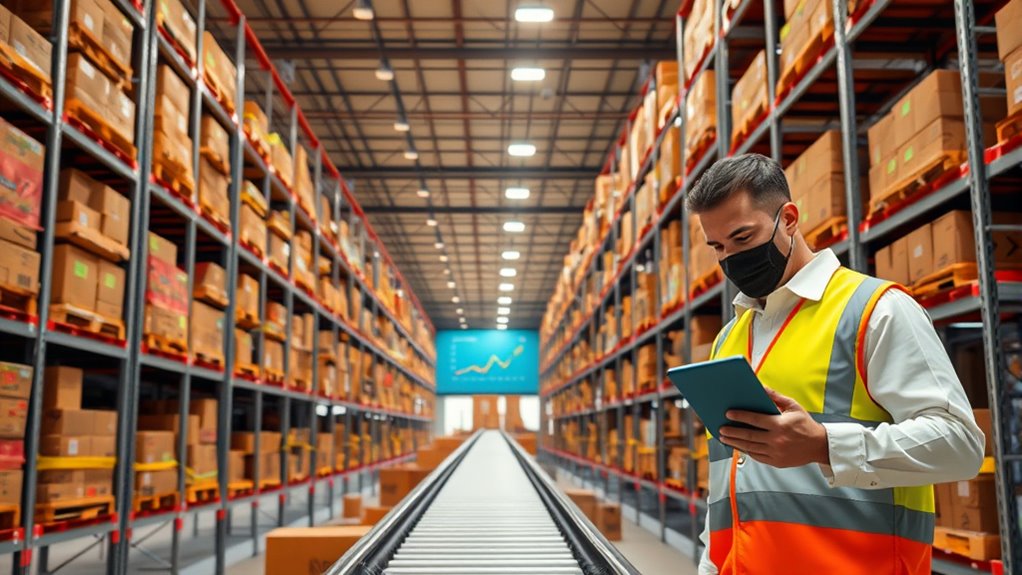To build supply chain resilience after the pandemic, focus on diversifying suppliers, adopting advanced technology like AI and real-time data systems, and maintaining safety stocks to prevent disruptions. Moving beyond just-in-time strategies helps absorb shocks while strategic inventory management keeps costs under control. Embracing a mindset of proactive planning and forging strong supplier relationships are essential. Staying ahead of these practices can empower you to navigate future risks effectively. Continue to explore ways to strengthen your supply chain’s resilience.
Key Takeaways
- Building supply chain resilience requires strategic inventory management, including safety stock and real-time tracking.
- Technology adoption, such as cloud systems and AI analytics, enhances responsiveness and demand forecasting.
- Diversifying suppliers across regions reduces vulnerability to localized disruptions and supply shocks.
- Proactive planning and continuous data updates enable quick adaptation to market and supply chain changes.
- Developing a resilient mindset involves investing in technology, fostering supplier relationships, and preparing for future risks.

Have you ever wondered how companies bounce back quickly from disruptions? The secret often lies in their ability to adapt and strengthen their supply chain strategies. After the pandemic, many organizations realized that a resilient supply chain isn’t just about quick fixes but requires proactive planning and smart decisions. One key aspect is effective inventory management. Instead of relying solely on just-in-time inventory, which can leave you vulnerable during sudden disruptions, you learn to balance stock levels. Maintaining safety stock or buffer inventories ensures that you can meet customer demands even when supply chain hiccups occur. This approach reduces the risk of stockouts and delays, giving your business a cushion to absorb shocks. You start tracking inventory more closely, using data analytics and real-time updates to better forecast demand and adjust stock levels accordingly. This way, you avoid overstocking, which ties up capital, and understocking, which risks losing sales. Additionally, adopting technology-enabled inventory systems can significantly improve your responsiveness and accuracy in managing stock levels.
Another vital strategy is supplier diversification. Relying on a single supplier or a limited number of sources can make you vulnerable if one of them faces issues. After the pandemic, you recognize that spreading your risk across multiple suppliers and regions minimizes the impact of localized disruptions. You begin seeking alternative suppliers, even for critical components, so that if one source encounters delays or closures, your entire supply chain doesn’t come to a halt. Diversification also involves evaluating suppliers based on their resilience, financial stability, and geographic location. By building relationships with multiple suppliers, you gain flexibility and bargaining power, reducing dependency on any single entity. It’s about creating a network of trusted partners that can step in when needed.
Incorporating these practices requires a mindset shift. You start investing in technologies that enhance your inventory management—like cloud-based systems and AI-driven analytics—so you can respond swiftly to changes. You also prioritize supplier relationships, fostering communication and collaboration that enable quick adjustments. These measures don’t just help you recover faster from disruptions; they also make your supply chain more adaptable to future shocks. You become proactive rather than reactive, continuously updating your strategies based on the latest data and market conditions. By doing so, you build resilience into your supply chain, making it less susceptible to unpredictable events and better equipped to sustain your business in uncertain times. In the end, strategic inventory management combined with supplier diversification is your best defense against future disruptions, helping you stay competitive and reliable in a rapidly changing world.
Frequently Asked Questions
How Can Small Businesses Improve Supply Chain Resilience?
You can improve your supply chain resilience by focusing on inventory management and supplier diversification. Keep a balanced inventory to avoid shortages and overstocking, ensuring you’re prepared for disruptions. Additionally, diversify your suppliers so you’re not overly dependent on one source; this reduces risks if a supplier faces issues. Regularly review and update your supply chain strategies to adapt to changing circumstances, strengthening your business’s ability to bounce back quickly.
What Emerging Technologies Are Shaping Supply Chain Resilience?
Think of your supply chain as a well-tuned orchestra. Blockchain integration guarantees transparency and security, like a conductor’s baton, while AI-driven forecasting acts as your crystal ball, predicting disruptions before they happen. These emerging technologies help you respond swiftly and adapt efficiently, strengthening resilience. By embracing blockchain and AI, you’re not just reacting to change—you’re orchestrating it, keeping your supply chain harmonious and resilient in an ever-evolving landscape.
How Do Geopolitical Tensions Impact Supply Chain Recovery?
Geopolitical tensions directly impact your supply chain recovery by increasing trade sanctions and geopolitical risks. These factors can disrupt your supplier relationships, delay shipments, and raise costs. You need to stay alert to international developments, diversify your sourcing options, and build flexible logistics strategies. Proactively managing these risks helps you adapt quickly, ensuring your supply chain remains resilient despite political uncertainties.
What Role Do Suppliers Play in Strengthening Resilience?
Like a trusted sidekick in a classic film, your suppliers play a vital role in strengthening resilience. You foster supplier collaboration to build stronger relationships, enabling quicker responses to disruptions. They help with risk mitigation by providing diverse sources and backup plans, making your supply chain more robust. By working closely with suppliers, you guarantee smoother operations and better adaptability, much like a well-coordinated team overcoming any challenge that comes your way.
How Can Companies Measure Supply Chain Resilience Effectively?
You can measure supply chain resilience effectively by conducting thorough risk assessments to identify vulnerabilities and evaluate your ability to respond to disruptions. Implement contingency planning to prepare for unexpected events, and regularly test these plans through simulations. Monitoring key performance indicators, such as lead times and inventory levels, helps you gauge resilience. Combining these strategies ensures you stay agile and ready to adapt when disruptions occur.
Conclusion
You might think building supply chain resilience is just about stockpiling or diversifying suppliers. But research shows true resilience comes from embracing technology and fostering strong relationships. It’s a myth that resilience is only about risk mitigation; instead, it’s about creating an adaptable, proactive approach. So, don’t just react to disruptions—anticipate and innovate. When you invest in these strategies, you’ll not only survive future shocks but thrive in an unpredictable world.








